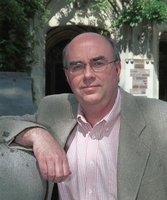Revisiting Decades-old Molecular Physics to Improve Modern Molecular Imaging
Date
November 6, 201311/06/2013 8:00am
11/06/2013 8:00am
Revisiting Decades-old Molecular Physics to Improve Modern Molecular Imaging


Warren S. Warren, PhD
James B. Duke Professor, Departments of Chemistry,
James B. Duke Professor, Departments of Chemistry,
Physics, Radiology and Biomedical Engineering
Director, Center for Molecular and Biomolecular Imaging French Family Science Center
Duke University, Durham, NC
Abstract:
Molecular imaging-the use of chemical signatures to image function instead of merely structure-promises to enable a new generation of clinical modalities that can revolutionize both diagnosis and treatment. I will focus on two specific modalities-magnetic resonance and optical imaging-and discuss how a close coupling between basic physics on the one hand, and focused clinical questions on the other hand, enable new and important applications. The theme will be the use of new pulse sequences or new technologies to extract information from endogenous contrast. In magnetic resonance, our group has shown that the fundamental physical framework, developed in the 1950s, left out some important effects. Our re-evaluation of that framework (published, for example, in six Science papers) has led to completely new ways to get contrast in magnetic resonance images. This has applications to functional brain imaging, to hyperthermic therapy for cancer treatment, and to brown fat imaging in humans-and to a new appreciation that low fields, not high fields, might well be the future for MRI. In optics, our lab has developed advanced femtosecond pulse shaping and detection technologies to access intrinsic nonlinear signatures that were not previously observable in tissue such as excited state absorption, ground state depletion, cross phase modulation. Applications to imaging hemoglobins and melanins in tissue will be highlighted, including recent work published in Science Translational Medicine which could revolutionize melanoma diagnosis by improving the pathology “gold standard”. I will also present work on nonlinear imaging of historical pigments to infer the artist’s original colors and intent.
America/Los_Angeles
public
Type
Lecture
Time Duration
12:05 PM

Warren S. Warren, PhD
James B. Duke Professor, Departments of Chemistry,
James B. Duke Professor, Departments of Chemistry,
Physics, Radiology and Biomedical Engineering
Director, Center for Molecular and Biomolecular Imaging French Family Science Center
Duke University, Durham, NC
Abstract:
Molecular imaging-the use of chemical signatures to image function instead of merely structure-promises to enable a new generation of clinical modalities that can revolutionize both diagnosis and treatment. I will focus on two specific modalities-magnetic resonance and optical imaging-and discuss how a close coupling between basic physics on the one hand, and focused clinical questions on the other hand, enable new and important applications. The theme will be the use of new pulse sequences or new technologies to extract information from endogenous contrast. In magnetic resonance, our group has shown that the fundamental physical framework, developed in the 1950s, left out some important effects. Our re-evaluation of that framework (published, for example, in six Science papers) has led to completely new ways to get contrast in magnetic resonance images. This has applications to functional brain imaging, to hyperthermic therapy for cancer treatment, and to brown fat imaging in humans-and to a new appreciation that low fields, not high fields, might well be the future for MRI. In optics, our lab has developed advanced femtosecond pulse shaping and detection technologies to access intrinsic nonlinear signatures that were not previously observable in tissue such as excited state absorption, ground state depletion, cross phase modulation. Applications to imaging hemoglobins and melanins in tissue will be highlighted, including recent work published in Science Translational Medicine which could revolutionize melanoma diagnosis by improving the pathology “gold standard”. I will also present work on nonlinear imaging of historical pigments to infer the artist’s original colors and intent.
